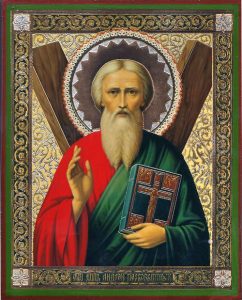St. Andrew

ക്രിസ്തുവിനെ അനുഗമിച്ച ആദ്യ ശിഷ്യന്മാര് വിശുദ്ധ പത്രോസിന്റെ സഹോദരനായ അന്ത്രയോസും, യോഹന്നാനുമാണ്. ക്രിസ്തുവുമായുള്ള ഇവരുടെ ആദ്യത്തെ കണ്ടുമുട്ടലിനെപ്പറ്റി വളരെ ലളിതവും മനോഹരമായും സുവിശേഷത്തില് വിവരിച്ചിരിക്കുന്നു (യോഹ 1:35-42). പത്രോസ്, യാക്കോബ്, യോഹന്നാന് തുടങ്ങിയ യേശുവിന്റെ അടുത്ത അപ്പസ്തോലന്മാരുടെ കൂട്ടത്തില് അന്ത്രയോസ് ഉള്പ്പെടുന്നില്ല.അതേ സമയം തന്നെ സുവിശേഷകരാകട്ടെ അസാധാരണമായി ഒന്നും അദ്ദേഹത്തെ കുറിച്ച് വിവരിക്കുന്നുമില്ല. പക്ഷേ അപ്പസ്തോല പ്രവര്ത്തനങ്ങളെ അടിസ്ഥാനമാക്കിയിട്ടുള്ള പഠനങ്ങള് ഈ വിശുദ്ധനു രക്ഷകനോടും കുരിശിനോടുമുള്ള അപാരമായ സ്നേഹത്തെ വളരെയേറെ എടുത്ത് കാട്ടുന്നു.
തിരുസഭയാകട്ടെ വിശുദ്ധ കുര്ബ്ബാനയിലും സഭയുടെ ദിവസേനയുള്ള ആരാധനക്രമ പുസ്തകത്തിലും ഈ വിശുദ്ധനെ പ്രകീര്ത്തിക്കുന്നു. ഗ്രിഗറി ഒന്നാമന് മാര്പാപ്പായുടെ കാലം മുതലാണ് ഈ വിശുദ്ധനെ ആദരിക്കുവാന് തുടങ്ങിയത്, തിരുസഭാചട്ടങ്ങളിലും, ലിബേറയിലും (വിശുദ്ധ കുര്ബ്ബാനയിലെ ഒരു ഭാഗം) ഈ വിശുദ്ധന്റെ നാമം ചേര്ക്കപ്പെട്ടത്. വിശുദ്ധ അന്ത്രയോസിന്റെ രക്തസാക്ഷിത്വത്തെ കുറിച്ചുള്ള കഥ അപ്പസ്തോല പ്രവര്ത്തനങ്ങളിലെ വിവരണങ്ങളില് നിന്നുമാണ് അറിവായിട്ടുള്ളത്.
ഇതനുസരിച്ച് വിജാതീയനായ ഒരു ന്യായാധിപന് വിശുദ്ധനോട് അവരുടെ ദൈവങ്ങള്ക്ക് ബലിയര്പ്പിക്കുവാന് ആവശ്യപ്പെട്ടു. എന്നാല് വിശുദ്ധന്റെ മറുപടി ഇപ്രകാരമായിരിന്നു, “ഞാന് നിത്യവും പരമകാരുണികനുമായ ഏക ദൈവത്തിന് ബലിയര്പ്പിക്കുന്നുണ്ട്, അവനാണ് ഏക ദൈവം. കാളയുടെ മാംസം കൊണ്ടോ ആടുകളുടെ ചോര കൊണ്ടോ അല്ല ഞാന് ബലിയര്പ്പിക്കുന്നത്. മറിച്ച്, അള്ത്താരയില് നേത്രങ്ങള്ക്ക് കാണുവാന് സാധ്യമല്ലാത്ത കുഞ്ഞാടിനെയാണ് ഞാന് ബലിയര്പ്പിക്കുന്നത്. എല്ലാ വിശ്വാസികളും ഇതില് പങ്കാളികളാവുകയും ഇതില് നിന്നും ഭക്ഷിക്കുകയും ചെയ്യുന്നു. എന്നാല് ബലിവസ്തുവായ കുഞ്ഞാടാകട്ടെ ഒരു കുഴപ്പവും കൂടാതെ എന്നെന്നും ജീവിക്കുന്നു.”
ഈ മറുപടിയില് കുപിതനായ ഈജിയാസ് വിശുദ്ധനെ തടവറയിലടക്കുവാന് ഉത്തരവിട്ടു. എന്നാല് അവിടെ കൂടിയിരുന്ന വിശ്വാസികള്ക്ക് ബുദ്ധിമുട്ടൊന്നും കൂടാതെ തന്നെ വിശുദ്ധനെ മോചിപ്പിക്കുവാന് സാധിക്കുമായിരുന്നു. എന്നാല് വിശുദ്ധന് വളരെ ആത്മാര്ത്ഥതയോട് കൂടി അങ്ങനെ ചെയ്യരുതെന്ന് ജനകൂട്ടത്തോട് യാചിക്കുകയും അവരെ ശാന്തരാക്കുകയും ചെയ്തു. രക്തസാക്ഷിത്വ മകുടത്തിനായി വിശുദ്ധന് അത്രമാത്രം ആഗ്രഹിക്കുന്നുണ്ടായിരുന്നു.
വിശുദ്ധനെ വധിക്കുവാനുള്ള സ്ഥലത്തേക്ക് കൂട്ടികൊണ്ട് വന്നപ്പോള് വിശുദ്ധ കുരിശിനെ നോക്കി അദ്ദേഹം ഇപ്രകാരം നിലവിളിച്ചുകൊണ്ട് പ്രാര്ത്ഥിച്ചു “ഓ, വിശുദ്ധ കുരിശേ, വളരെ നാളായി നിന്നെ പുല്കുവാന് ആഗ്രഹിക്കുന്ന എന്റെ ആത്മാവിന് ഇപ്പോള് അത് സാധ്യമാകും എന്നതില് ഞാന് ആനന്ദിക്കുന്നു; യാതൊരു മടിയുംകൂടാതെ നിന്നിലൂടെ മരണം വരിച്ചവന്റെ ഈ ശിഷ്യനെയും സ്വീകരിക്കണമേ.”
അധികം താമസിയാതെ അദ്ദേഹത്തെ ‘x’ ആകൃതിയിലുള്ള കുരിശില് തറച്ചു. രണ്ടു ദിവസത്തോളം വിശുദ്ധന് കുരിശില് ജീവനോടെ കിടക്കുകയും യേശുവിന്റെ പ്രബോധനങ്ങള് ഉത്ഘോഷിക്കുകയും അവസാനം ക്രിസ്തുവിനു സമാനമായ രീതിയില് മരണം വരിച്ചുകൊണ്ട് യേശുവിനോട് ചേരുകയും ചെയ്തു. വിശുദ്ധ കുരിശിന്റെ രഹസ്യം നമുക്ക് പ്രദാനം ചെയ്തു എന്ന നിലയിലും വിശുദ്ധ അന്ത്രയോസിന്റെ രക്തസാക്ഷിത്വം പ്രാധാന്യമര്ഹിക്കുന്നു.
The New Testament tells us that Andrew was the brother of Simon Peter. He was born in the village of Bethsaida on the sea of Galilee. Both Andrew and his brother were fishermen by trade, hence the tradition that Jesus called them to be his disciples by saying that he would make them “fishers of men”.
In the Gospel of Matthew (Matt 4:18=22) and in the Gospel of Mark (Mark 1:16=20), Simon Peter and Andrew were both called together to become disciples of Jesus and “fishers of men”. These narratives record for us that Jesus was walking along the shore of the sea of Galilee, saw Simon Peter and Andrew fishing, and called them to discipleship.
However, in parallel in this incident in the Gospel of Luke (Luke 5:1=11) Andrew is actually not named, and nor is there any mention of Simon Peter having a brother. In this, Jesus used a boat described as belonging to Simon, as a preaching platform for preaching to the multitudes on the shore, and then after as a way of achieving a huge catch of fish on a night which had hitherto proved to be fruitless. There is an indication that Simon was not the only fisherman present (they signalled to their partners in the other boat (Luke 5:7) but it is not until the next chapter that Andrew is named as Simon’s brother (Luke 6:14). Although it is generally understood that both Andrew and Simon were fishing on that night.
In contrast however, the Gospel of John (John 1:35=42) states that Andrew was original a disciple of John the Baptist before being led to follow Jesus.
Andrew is referred to in the Gospels as being present on some important occasions as one of the closest of Jesus’s disciples. Andrew told Jesus about the boy with the loaves and fishes (John 6:8), and when Philip wanted to tell Jesus about certain Greeks that were seeking him, he informed Andrew first (John 12:20=22). Andrew was also present at the last supper.
Andrew is said to have been martyred by crucifixion at the city of Patras in Achaea, on the northern coast of the Peloponnese. Early texts such as the Acts of Andrew known to Gregory of Tours, tell us Andrew was tied not nailed to a cross of the type on which Jesus is said to have been crucified, yet a tradition emerged that Andrew was crucified on a Crux decussata (an x=shaped cross), now commonly known as a St. Andrew’s cross. They say this was at his own request, as he deemed himself to be unworthy to be crucified on the same type as on which Jesus died.
Andrew is the patron saint of several countries and cities including : Barbados, Romania, Russia, Scotland, Ukraine, Amalfi in Italy, Esgueira in Portugal, Luga in Malta, Paranaque in the Philippines, and Patras in Greece. He was also the patron saint of Prussia and of the Order of the Golden Fleece.
The feast of Andrew is observed on the 30th November in Eastern and Western churches, and it is also the national day of Scotland.
In the traditional liturgical books of the Catholic Church, the feast of St. Andrew is the first feast day in the Proper of Saints.
Source : www.syromalabarperth.org.au